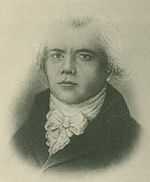Johan Gadolin
| Johan Gadolin | |
|---|---|
 Johan Gadolin | |
| Born |
June 5, 1760 Turku |
| Died | August 15, 1852 (aged 92) |
| Nationality |
|
| Fields | Chemistry |
| Known for | Yttrium |
Johan Gadolin (5 June 1760 – 15 August 1852) was a Finnish chemist, physicist and mineralogist. Gadolin discovered the chemical element yttrium. He is also considered the founder of Finnish chemistry research, as the second holder of the Chair of Chemistry at the Royal Academy of Turku.
Early life
Johan Gadolin was born in Åbo (current day Turku), Finland (then a part of Sweden), as the son of Jakob Gadolin. He began to study mathematics at the Royal Academy of Turku when he was fifteen. Soon he found mathematics too laborious and changed his major to chemistry. In 1779 Gadolin moved to Uppsala University where he was taught by Torbern Bergman.
In 1790, he was elected a member of the Royal Swedish Academy of Sciences.
Chemistry
Gadolin became famous when he discovered the first rare earth element. In 1792 Gadolin received a sample of black, heavy mineral found in a quarry in the Swedish village Ytterby near Stockholm. By careful experiments, he isolated a rare earth oxide which was later named yttria. He also isolated in the same study yttrium trihydroxide. Yttria, or yttrium oxide, was the first known rare earth metal compound — at that time, it was regarded as an element. The work was published in 1794.
The mineral that Gadolin examined was named gadolinite in 1800. The element gadolinium and its oxide gadolinia were named after Gadolin by its discoverers.
In an earlier paper in 1788 Gadolin showed that the same element can show several oxidation states, in his case Sn(II) and Sn(IV) 'by combining itself with larger or smaller amounts of the calcinating substance'. He vividly described the disproportionation reaction:
- 2 Sn(II)
 Sn(0) + Sn(IV).
Sn(0) + Sn(IV).
Gadolin also studied specific heats and latent heats in 1787–92. This thermochemical work was very precise.
One of his latest studies was the chemical analysis of the Chinese alloy pak tong (alpacca, German silver) in 1810 and 1827.
Gadolin became the professor of chemistry at the Royal Academy of Turku in 1797. He was one of the first chemists who gave laboratory exercises to students. He even allowed the students to use his private laboratory. Gadolin wrote the first anti-phlogiston chemistry textbook in the Nordic countries.
He was close friends with Johan Gottlieb Gahn and Carl Wilhelm Scheele.
Gadolin is also famous for publishing one of the earliest examples of counter-current condensers, today usually referred to as Liebig condensers.
References
- Dean, P B; Dean, K I (August 1996). "Sir Johan Gadolin of Turku: the grandfather of gadolinium.". Academic Radiology 3 (Suppl 2): S165–9. doi:10.1016/S1076-6332(96)80523-X. PMID 8796552.
- Weeks, Mary Elvira (1932). "The discovery of the elements: XVI. The rare earth elements". Journal of Chemical Education 9 (10): 1751–1773. Bibcode:1932JChEd...9.1751W. doi:10.1021/ed009p1751.
- Sella, Andrea (2009). "Gadolin's Condenser". Chemistry World 6 (10): 81–81.
- Pyykkö, Pekka and Orama, Olli (1988). "Johan Gadolin's 1788 paper mentioning the several oxidation states of tin and their disproportionation reaction". Nouveau J. Chimie / New J. Chem. 12: 881–883.
- Pyykkö, Pekka and Orama, Olli (1996). "What did Johan Gadolin actually do?". Episodes from the History of the Rare Earth Elements, Ed. C. H. Evans, Kluwer, Dordrecht: 1–12.
External links
|